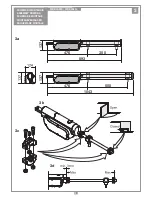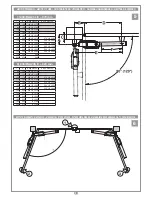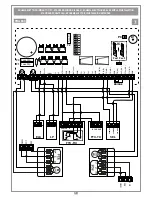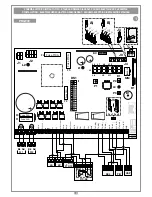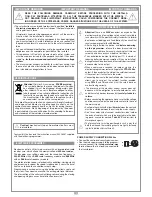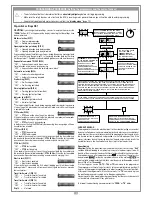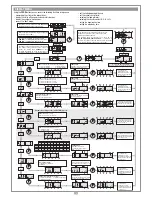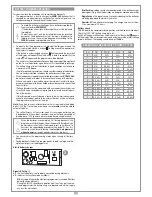
14
The system can be remotely activated using radio control devices; to set the
two functions to channels
A-B-C-D
use the selection jumper “
J3
”:
- in position “
A
” function 1 is selected,
SEQUENTIAL COMMAND
;
- in position “
B
” function 2 is selected,
CH2
(
binding posts 8, 9
) only if "
J5
"
is in position 2.
The sequential command may be set (dip “
3
”) to “
open-block-close-block
”
or “
open-close
”.
Memory module (MM)
This is extractable, furnished with a non volatile EEPROM type memory and
contains the transmitter codes and allows you to memorise up to
300 codes
.
The programmed codes are maintained in this module even during blackouts.
Before memorising the transmitters for the first time remember
to cancel the entire memory content. If the electronic card has
to be replaced due to failure, the module can be extracted from
it and inserted into the new card. Make sure that the module is
correctly inserted as shown on page 2.
Signal LED "L3"
:
Flashing quickly:
cancels a single code
Flashing slowly:
memorises a single code
Permanently lit:
memory full.
TRANSMITTER CODE MANAGEMENT
Memorising a channel:
1. Press and hold down button "
P2
"
MEMO
: The LED "
L3
" will flash slowly.
2. At the same time activate the transmitter which is to be memorised.
3. Hold down button "
P2
"
MEMO
until LED "
L3
" starts to flash again.
4. Release the
MEMO
button: The LED will continue to flash.
5. Activate the transmitter again (same transmitter, same channel; if the
channel is different or it is a different transmitter the memorisation attempt
will abort without success).
6. End of memorisation: the LED "
L3
" will remain lit for 2 seconds, indicating
that the transmitter has been correctly memorised.
Notes:
It is not possible to memorise a code which is already in memory: if
you attempt this, the LED will switch off when you activate the transmitter
(point 2). Only after releasing the button "
P2
"
MEMO
will you be able to
continue the memorising procedure.
If after activating the transmitter for the first time you wait for more than fifteen
seconds without activating the transmitter a second time the memorisation
attempt will abort without success.
Cancelling a channel:
1. Press and hold down the button "
P3
"
DEL
: the LED "
L3
" will flash quickly.
2. Activate the transmitter channel that is to be cancelled.
3. The LED will remain lit for 2 seconds, indicating that the transmitter has
been cancelled.
Notes:
If the user that you wish to cancel is not in memory, the LED will stop
flashing; only after releasing the button "
P3
" will you be able to continue the
cancellation procedure.
For both the memorisation and cancellation procedures, if the button is
released before activating the transmitter the procedure will abort.
Cancelling all user codes from memory:
1. Keep both buttons pressed down ("
P2+P3
") for more than four seconds.
2. LED "
L3
" will remain lit during the entire cancellation time (about 8 seconds).
3. LED "
L3
" switches off when the cancellation procedure has terminated.
Note:
When the memory is almost full the time required to search for a user
code could take up to 1 second from when the command was received.
If LED
"L3"
remains lit memory is completely full. To memorise a new trans-
mitter you will first have to cancel a code from memory.
Memorising ulterior channels via radio
• Memorisation can be activated by radio (without opening the receiver
container) if jumper "
J4
" has been inserted (fig. 1).
1. Make sure that the jumper "
J4
" has been inserted.
2. Using a transmitter, in which at least one channel button "
A, B, C
or
D
" has
already been memorised in the receiver, press the button in the transmitter
as shown in figure.
Note:
all the receivers within range when the channel button is pressed (and
which have at least one of the transmitter channel buttons memorised) will
activate their signal buzzer "
B1
" (fig. 1).
3. Press one of the channel buttons on the same transmitter. The receivers
which do not contain that channel code will sound a five-second long
"beep" and will then deactivate. The receivers which contain the channel
code will sound a one-second long "beep" and will enter the "
program-
ming via radio"
mode.
4. Press the previously chosen channel but-
tons on the transmitter which you wish to
memorise; the receiver will sound 2 "beeps"
of half a second each after which the receiver
will be ready to receive another code.
5. To leave the programming mode wait for
3 seconds without pressing any buttons. The receiver will sound a five-
second long "beep" and will then exit the programming mode.
Note:
When the memory is entirely occupied the buzzer will sound 10 rapid
"beeps" and will automatically leave the "
programming via radio
" mode.
LED "
L3
" will remain lit on the receiver.
The same signal is given each time you try to enter "
programming via radio
"
when the memory is full.
CONNECTING THE ANTENNA
Connect an
ANS400
tuned antenna using a coaxial cable
RG58
(impedance
50
Ω
) with a maximum length of
15 m
.
1) Automatic
Selected by enabling automatic reclosing (dip "
4
" in position "
ON
"). When
the door is completely closed the opening command will start a complete
cycle which will end with automatic reclosing.
Automatic reclosing starts after the programmed pause period has elapsed
when the opening cycle has been completed or straight away after the
intervention of a photoelectric cell (the intervention of a photoelectric cell
causes the pause time to be reset).
During the pause time the symbol will flash on the display and pressing
the blocking button during this period will stop automatic reclosing and
consequently stop the display from flashing.
The indicator light remains lit until the closing manoeuvre has terminated.
Note:
the courtesy light switches on each time a movement command is
given (both via cable or via radio) and switches off 30 seconds after the
manoeuvre has been completed (only if jumper "
J5
" is in position "
1
", fig. 1).
2) Semiautomatic
Selected by deactivating automatic reclosing (dip "
4
" in position "
OFF
").
Work cycle control using separate opening and closing commands. When
the door has reached the completely open position the system will wait until
it receives a closing command either via an external control button or via
radio control, before completing the cycle.
The indicator light remains lit until the closing manoeuvre has terminated.
3) Manual manoeuvring with released motors
Releasing the motor the gate can be moved by hand.
LIMITED OPENING
This always effects gate 1; the limited opening space can be set (see display
menu) to 1/3, half, 2/3 or the entire opening distance for gate 1.
The command can only be carried out with both gates completely closed; if
dip
"
3
"
is set to “
OFF
” and during opening you activate the “
TAL
” command
again gate leaf 1 will block and when it receives the next command it will move
in the closing direction.
At this point the command cannot be used again until complete closure.
COURTESY LIGHT /CH2 RADIO OUTPUT
Binding posts “
7
”,“
8
” are linked to a C-NO relay; this can be activated as follows:
- jumper
J5
in position 1: the contact is closed by a timer and works as a
“courtesy light”
- jumper
J5
in position 2: the contact works as a second radio channel.
Binding posts “
7
”,”
8
” only give a potential free contact; this means that the
courtesy light will have to be powered by an external circuit and the contact
used as a simple switch.
REMOTE CONTROL (fig. 1 - page 2)
MEMORIZZAZIONE CODICE TX-RX
RCQ449100
13-04-2001
DM0531
Description :
Product Code :
Date :
Drawing number :
P.J.Heath
CARDIN ELETTRONICA S.p.A
- 31020 San Vendemiano (TV) Italy - via Raffaello, 36 Tel: 0438/401818 Fax: 0438/401831
Draft :
All rights reserved. Unauthorised copying or use of the information contained in this document is punishable by law
MR
FUNCTION MODES



